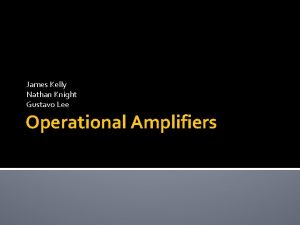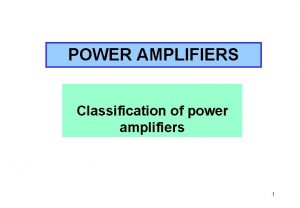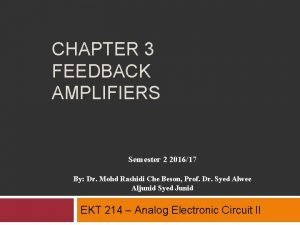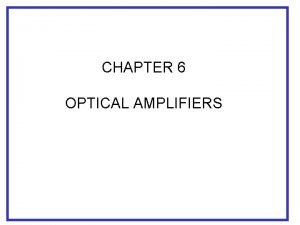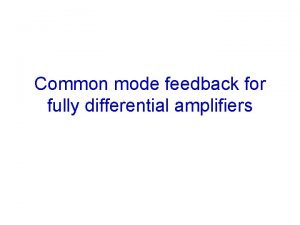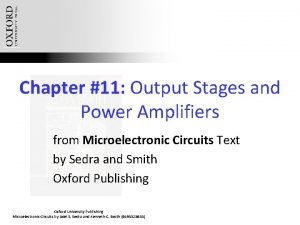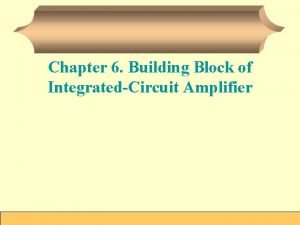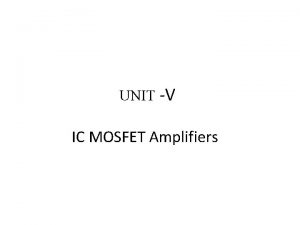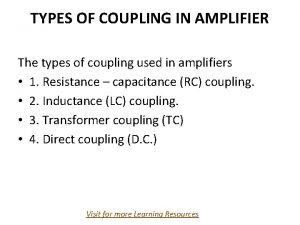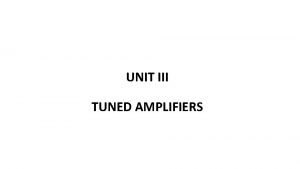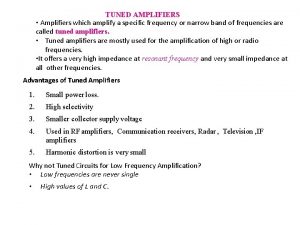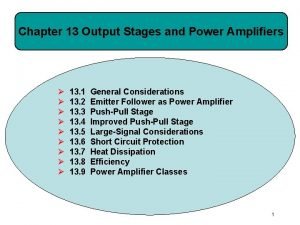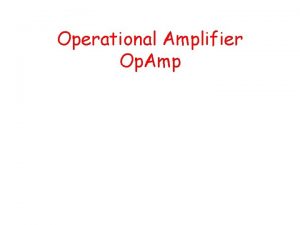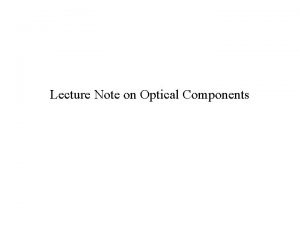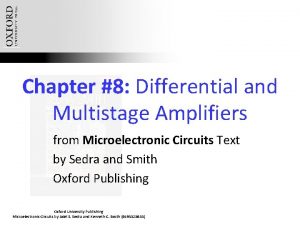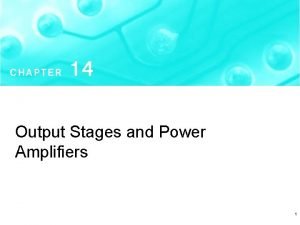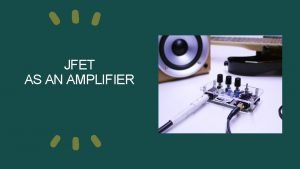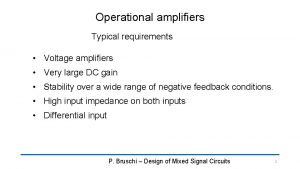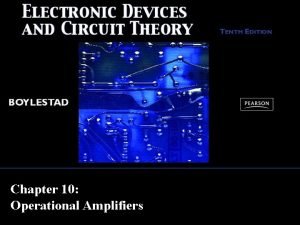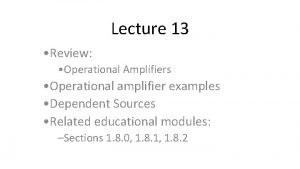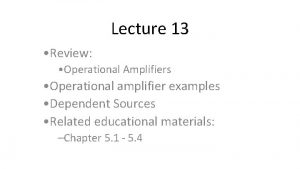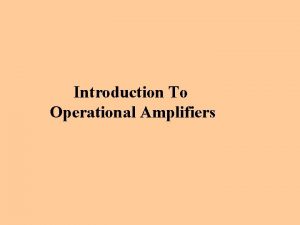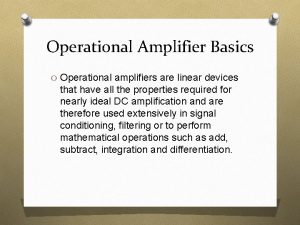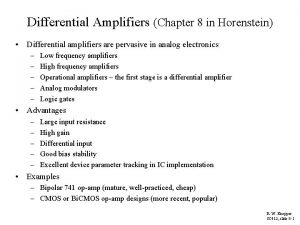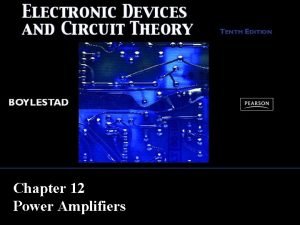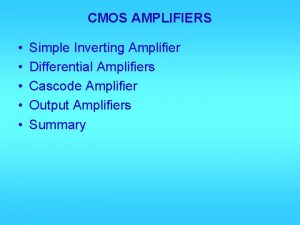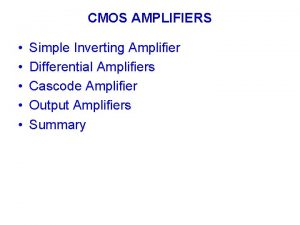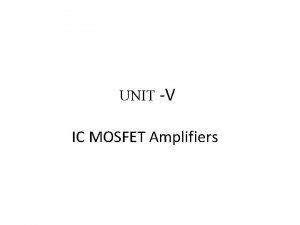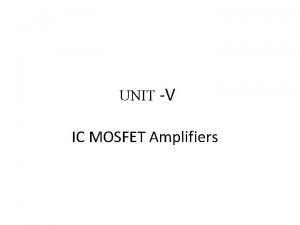James Kelly Nathan Knight Gustavo Lee Operational Amplifiers
































- Slides: 32

James Kelly Nathan Knight Gustavo Lee Operational Amplifiers

Presentation Outline � Introduction � Characteristics of Ideal and Real Op-Amps � Basic Circuits of Op-Amps � Applications � Exercise

What is an Op-Amp? � An Operational Amplifier (known as an “Op-Amp”) is an integrated circuit that sets an output voltage based on the input voltages provided. � In a circuit, it is used to perform an operation and an amplification where the operation may be add, subtract, filter, integrate, differentiate, etc. � Op-Amps are composed of transistors, resistors, capacitors, and diodes.

Brief History � 1941: Karl Swartzel of Bell Labs developed the first Op-Amp. Used 3 vacuum tubes, only one input (inverting), and operated on + 350 V to achieve 90 d. B gain. � 1947: Loebe Julie developed the Op-Amp as it is known today, with two inputs – inverting and non-inverting. The differential input made a whole range of new functionality possible. � 1953: First commercially available Op-Amp. George A. Philbrick Researches (GAP-R). GAP-R pioneered the first reasonable-cost, mass-produced operational amplifier � 1961: Advent of solid-state, discrete Op-Amps. Made possible by the invention of the silicon transistor, which led to the concept of Integrated Circuits (IC) Reduced power input to ± 15 V to ± 10 V � 1962: Op-Amp in a potted module. Packaging in small black boxes allowed for integration with a circuit

Brief History � 1963: First monolithic IC Op-Amp, the μA 702, designed by Bob Widlar at Fairchild Semiconductor. Monolithic ICs consist of a single chip � 1968: Release of the μA 741 The μA 741 became the canonical Op-Amp, from which many modern op-amps base their pinout from, and is still in production today. Parameter Range Frequency Spectrum 5 -k. Hz to beyond 1 -GHz GBW Supply Voltage 0. 9 V to a maximum 1000 V Input Offsets Approximately Zero

Presentation Outline � Introduction � Characteristics of Ideal and Real Op-Amps � Basic Circuits of Op-Amps � Applications � Exercise

Basic Op-Amp (Open-Loop) �

Ideal Op-Amp Parameter Name � Input impedance Output impedance Open-loop gain Bandwidth Symbol Value

Real Op-Amp Parameter Name � Input impedance Output impedance Open-loop gain Bandwidth Symbol Value

Saturation Vout � Vsat+ Slope = G Vin Vsat- Saturation Cutoff Points

Presentation Outline � Introduction � Characteristics of Ideal and Real Op-Amps � Basic Circuits of Op-Amps � Applications � Exercise

Open Loop vs. Closed Loop �A closed-loop op-amp has feedback from the output back to one of the inputs, whereas an open-loop op-amp does not. Open-Loop Closed-Loop

Negative vs. Positive Feedback � Negative feedback connects the output to the inverting input (-), whereas positive feedback connects the output to the non-inverting input (+). Negative Feedback Positive Feedback

Negative vs. Positive: Output � Negative feedback op-amps can produce any voltage in the supply power range. � Positive feedback op-amps can only produce the maximum and minimum voltages of the range. Vout Vsat+ Vin Vsat. Negative Feedback Vin Vsat. Positive Feedback

Inverting Op-Amp �

Non-Inverting Op-Amp �

Integrating Op-Amp �

Derivative Op-Amp �

Differential Op-Amp �

Summing Op-Amp �

Presentation Outline � Introduction � Characteristics of Ideal and Real Op-Amps � Basic Circuits of Op-Amps � Applications � Exercise

Applications �Active filters Signal processing Digital Image processing �Strain gauges �Control circuits PID controllers for aircraft PI controllers for temperature measurement circuitry �And much more…

Low-Pass Filter � High-Pass Filter

Bandpass Filter Notch Filter

Strain Gauge Strain gauges consist of a pattern of resistive foil mounted on a backing material. � As the foil is subjected to stress, the resistance of the foil changes in a defined way. � This results in an output signal directly related to the stress value, typically a few millivolts. � Op-Amps are utilized to amplify the output signal level to 5~10 V, a suitable level for application to data collection systems. �

PID Controller �

PID Controller �

And much more… �Comparators �Detectors Threshold detector Zero-level detector �Oscillators Wien bridge oscillator Relaxation oscillator �Level shifters

Presentation Outline � Introduction � Characteristics of Ideal and Real Op-Amps � Basic Circuits of Op-Amps � Applications � Exercise

Exercise �

References � � � � � Cetinkunt, Sabri. Mechatronics. Hoboken, NJ: John Wiley & Sons Inc. , 2007. Jung, Walter G. Op Amp Applications Handbook. Analog Devices, Inc. , 2005. “Operational Amplifier. ” http: //en. wikipedia. org/wiki/Operational_amplifier. “Operational Amplifier Applications. ” http: //en. wikipedia. org/wiki/Operational_amplifier_applications. “The Strain Gauge. ” http: //web. deu. edu. tr/mechatronics/TUR/strain_gauge. htm. “The PID Controller. ” http: //en. wikipedia. org/wiki/PID_controller. “Feedback in Electronic Circuits: An Introduction. ” http: //ecee. colorado. edu/~ecen 4827/lectures/dm_feedback 1. pdf. “Differentiator and Integrator Circuits” http: //www. allaboutcircuits. com/vol_3/chpt_8/11. html. “Inverting Op-Amp” http: //www. wiringdiagrams 21. com/2009/12/17/basicinverting-op-amp-circuit-diagram/

The End �Questions?
 Operational amplifier is also called as
Operational amplifier is also called as Gustavo lee
Gustavo lee Circuit
Circuit Power absorbed or delivered
Power absorbed or delivered Barth
Barth Positive feedback application
Positive feedback application In-line optical dwdm amplifiers
In-line optical dwdm amplifiers Common mode feedback
Common mode feedback Voltage series feedback amplifier
Voltage series feedback amplifier Classification of output stages
Classification of output stages Building blocks of integrated-circuit amplifiers中文
Building blocks of integrated-circuit amplifiers中文 A cs amplifier utilizes a mosfet with
A cs amplifier utilizes a mosfet with Differential and multistage amplifiers
Differential and multistage amplifiers Different types of coupling in amplifiers
Different types of coupling in amplifiers Applications of tuned amplifier
Applications of tuned amplifier In tuned amplifiers harmonic distortion is
In tuned amplifiers harmonic distortion is Output stages and power amplifiers
Output stages and power amplifiers Isolated instrumentation amplifier
Isolated instrumentation amplifier Output impedance of op amp
Output impedance of op amp Optical amplifiers lecture notes
Optical amplifiers lecture notes Classification of power amplifiers
Classification of power amplifiers Angels in amplifiers
Angels in amplifiers Differential and multistage amplifiers
Differential and multistage amplifiers Output stages and power amplifiers
Output stages and power amplifiers Amplification factor in jfet
Amplification factor in jfet James russell odom
James russell odom Criminal profiling of serial killers
Criminal profiling of serial killers Gustavo giovannoni
Gustavo giovannoni Una leyenda
Una leyenda Gustavo rocha edad
Gustavo rocha edad Lus gustavo
Lus gustavo Gustavo rodriguez-rivera
Gustavo rodriguez-rivera Gustavo bruni
Gustavo bruni

